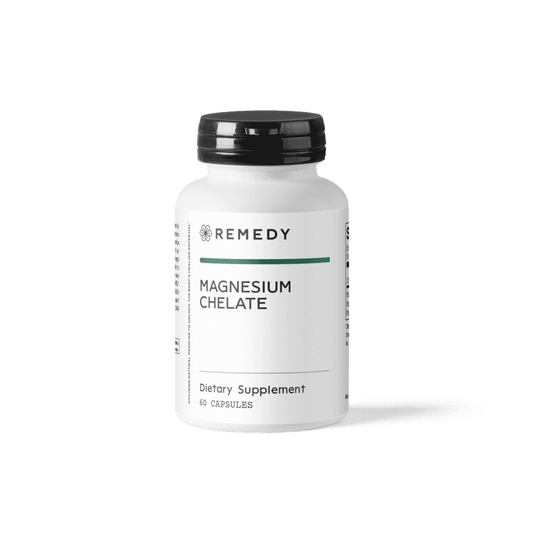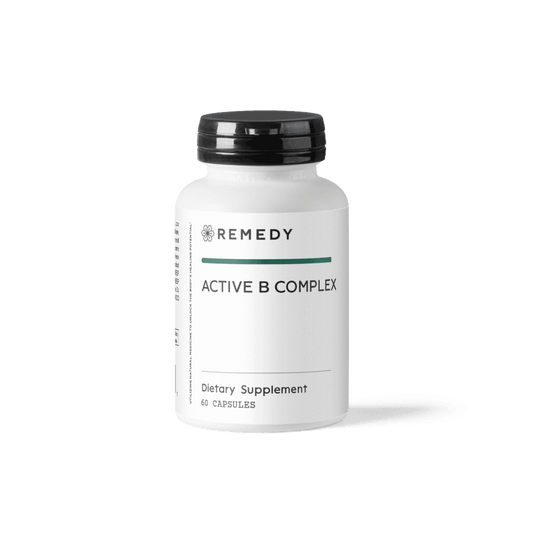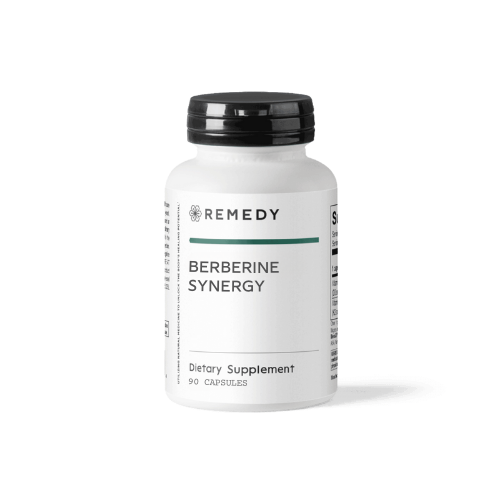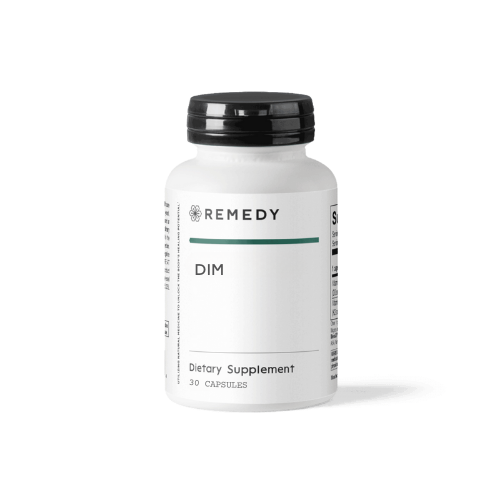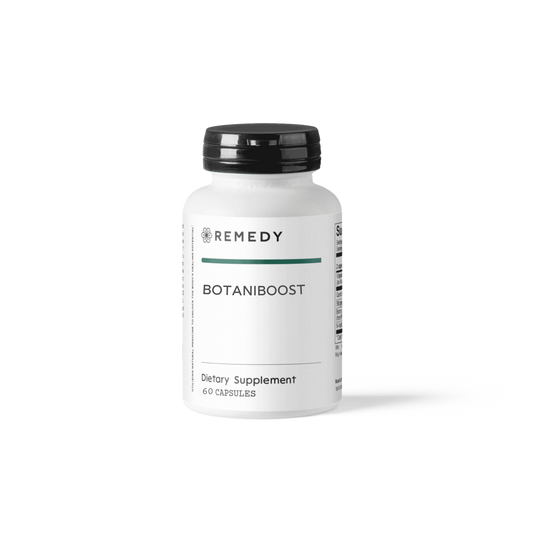Share
Estrogen can wreak havoc on your body if it’s not balanced by progesterone.
Estrogen dominance is a popular term in the functional medicine community. If you’ve done any research on hormonal imbalances you’ve heard of it, and you may have a few questions. While not technically a medical diagnosis, estrogen dominance covers an umbrella of symptoms linked to elevated levels of estrogen relative to its counterpart progesterone.
It is not a standalone medical condition like adrenal cancer that causes gross elevations in estrogen. Instead, it refers to a hormonal imbalance that is influenced by diet, lifestyle, and natural hormonal fluctuations. Estrogen dominance is frequently identified in functional medicine practices. It’s often a root cause of symptoms like gut dysbiosis, painful periods, and mood swings.
Estrogen can wreak havoc on your body if it’s not balanced by progesterone. In this article, I’ll answer all your questions about estrogen dominance.
What is the connection between estrogen and progesterone?
Estrogen is a reproductive hormone that is responsible for the physical changes women experience during puberty. It is important for the first half of your menstrual cycle where it builds up the uterine lining and prepares the uterus for a baby. Estrogen also keeps the body lubricated - anything from joints to the vagina. Estrogen can support men’s reproductive health to a lesser degree.
It affects skeletal growth, skin, fat and protein deposition, and electrolyte balance.
On the other hand, progesterone is important for the second half of your menstrual cycle. It counterbalances estrogen by keeping the lining from getting too thick and is one of the main hormones responsible for supporting a pregnancy. Progesterone also plays a significant role in healthy sleep patterns and emotions. We can dive into the hormonal cascade (everything is connected!) later, just know that progesterone is the building block for many other major hormones.
Simply put, estrogen and progesterone work hand in hand to balance each other.
What does it mean to have high estrogen levels?
When you think about estrogen dominance you probably imagine high estrogen levels. That is true in some cases, but not all. There are actually two main instances where estrogen dominance occurs.
The first is when estrogen levels are high, but progesterone levels are normal. This means that you might have excess body fat, microbiome imbalances, poor digestion, impaired liver detoxification, or xenoestrogens acquired from the environment that cause elevated estrogen levels.
The other situation is when estrogen levels are normal, but progesterone levels are low. This means estrogen levels are high in relation to progesterone levels. It may be due to peri-menopause, PCOS, stress or inflammation, or even hormonal birth control.
How does estrogen dominance make you feel?
Estrogen dominance makes you feel many of the symptoms of premenstrual syndrome (PMS). They’re not enjoyable feelings, but are often easy to ignore or write off as “normal.” To the point, what begins as mild symptoms in younger years often becomes moderate in the mid to late 30s, and severe by the time a woman reaches her mid-40s!
Here are signs of estrogen dominance to look out for:
- Breast tenderness
- Mood swings
- Fluid retention
- Weight gain
- Headaches
- Menstrual cramps
- Irregular menstruation
- Hair loss
- Fatigue
- Thyroid dysfunction
- Endometriosis
- Polycystic ovary syndrome
- Fibrocystic breasts
- Infertility
- Insomnia and fatigue
What causes estrogen dominance?
The cause of estrogen dominance is usually multifactorial. That simply means there is more than one reason involved. Hormone mimicking chemicals in the environment as well as the food you eat both contribute to elevated estrogen levels.
For example, pesticides, herbicides, and fungicides found in conventional produce are known endocrine disruptors that interfere with your natural hormone activity. That’s why it’s important to choose organic food when you can.
Meanwhile, xenoestrogens are hormone-mimicking chemicals that are absorbed directly into your tissue. They’re found in all sorts of products like household cleaners, furniture, and even makeup, shampoos, and lotions. Parabens, phenoxyethanol, phthalates, and other chemical compounds are examples of endocrine-disrupting chemicals you should avoid.
Other potential causes of estrogen dominance include excessive body fat, gut dysbiosis, birth control, BPA in plastics, heavy metals, and chronic stress.
How do you test for estrogen dominance?
Symptoms like heavy, painful periods for months on end, breast tenderness, and migraines are all obvious signs of estrogen dominance. However, you most likely want to test to be sure. There are a few ways to test for estrogen dominance.
I recommend a functional lab test approach to review hormones and that you work with a functional medicine practitioner to help you choose the correct test and evaluate optional ranges and balances. There are many types of tests available to evaluate hormones including blood, saliva, and urine and it is important to choose the right one for you. I commonly use salivary tests or the DUTCH hormone test with clients.
Can you treat estrogen dominance?
You can treat estrogen dominance when you understand the root cause of your symptoms.
Due to the many factors that cause estrogen dominance, any treatment protocol will be highly personalized. It will likely include lifestyle and diet changes to reduce your exposure to xenoestrogens and supplement your wellbeing with healthy food.
Here are some important steps to help treat estrogen dominance that you can likely expect to be a part of your protocol:
- Improve nutrition - Food plays a huge role in hormone balance. It’s important for estrogen metabolism, liver detoxification, and the removal of excess estrogen via the colon. A fiber-rich diet full of colorful vegetables is a great place to start.
- Improve digestion - Estrogen metabolites leave the body via the digestive tract, so it’s important to have regular bowel movements. If you are constipated, estrogen metabolites that are meant to leave will recirculate in the body. In addition, there is a portion of the gut microbiome, called the estrobolome, which involves a collection of enzymes that interact with estrogen. A healthy microbiome is key for hormone balance.
- Support liver detoxification - Before estrogen gets to the colon and interacts with the estrobolome, it must pass through two phases of liver detoxification. This is where personal genetics and nutrition status plays a great role.
- Avoid xenoestrogens - The average woman uses 10-15 personal care products a day. Imagine how many chemicals are introduced into your body on a daily basis. Xenoestrogens bind to estrogen receptors, contribute to estrogen dominance and place additional stress on the body. The best strategy here is to limit exposure by controlling what you can. Click here for my favorite clean beauty products.
Work with a Functional Medicine Practitioner to Treat Estrogen Dominance
Identifying and treating estrogen dominance is highly dependent on each woman’s unique situation. The functional medicine approach starts with identifying the root cause, using comprehensive testing, and building a plan to balance hormones and restore function within the body.
The beauty of the functional medicine approach to estrogen dominance is that we have a lot of tools to use, which can be gentle and effective. If you’re interested in learning more, let’s schedule a free fifteen-minute consultation!


